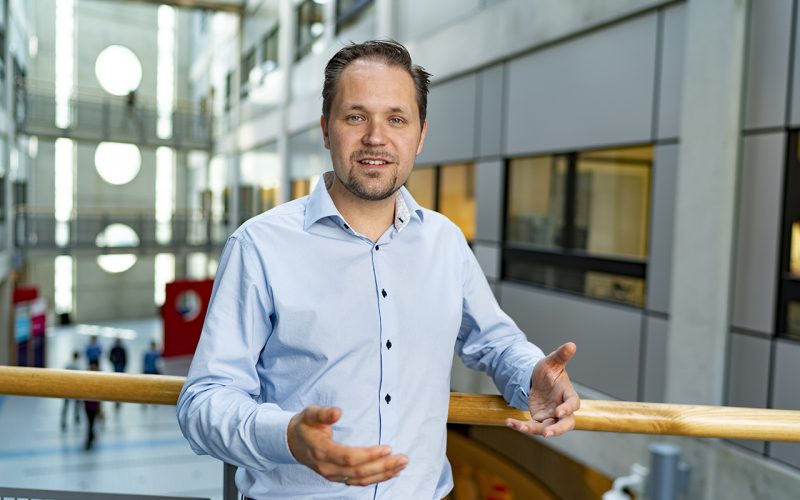Irreparably damaged cells are a cause of many aging diseases, including cancer. These cells, also known as senescent cells, can now be eliminated. This is how associate professor Peter de Keizer hopes to combat cancer and other diseases. Here, we talk to Peter about his research and his fascination for these senescent cells.
You are specialized in the ‘biology of aging’. What does that entail?
“Exactly what you would expect: someone who studies aging. I do so mainly at the smallest level, that of cells and molecules. I am interested in understanding how and why we age. Just by living, damage accumulates in our bodies. At some point, cells become stressed and damaged beyond repair and lose their function. In other words: the cells become ‘senescent’. The number of senescent cells accumulates as we age, playing a role in a wide range of aging diseases, including cancer. Senescent cells release all kinds of molecules that cause surrounding cells to also start aging. I am particularly interested in how that process works and how we could stop it.”
In 2004, Peter started his PhD at UMC Utrecht where his focus was on a group of proteins, the FOXO proteins. He then worked for several years in the San Francisco Bay area. There, in 2009, he discovered that one of these FOXO proteins, FOXO4, is an essential factor that prevents senescent cells from dying. Now, nearly 20 years later, the first clinical trials to test a drug that eliminates these senescent cells in cancer patients will start in a year’s time at UMC Utrecht.
What do senescent cells have to do with cancer?
“Senescent cells contribute to the development of cancer in several ways. High numbers of various subtypes of senescent cells are found in advanced cancer types. Senescent cells themselves can also turn into cancer cells when they acquire additional DNA-mutations. “We see this in as many as a quarter to a third of patients with colon, ovarian or breast cancer. Here, the DNA of the cells is immensely scarred. And for these scarred cancer cells, we have now found something to eliminate them.”
“After all these years, I still find it fascinating how cells change during our lifetime and contribute to aging and cancer.”
You have found something to eliminate these scarred cells: how exactly does that work?
“Senescent cells require the chemical bond between the two proteins FOXO4 and P53 to stay alive. By studying this attachment closely, we were able to develop a small piece of protein that can disrupt it.”
This innovative approach turned out to be successful with mice: the drug Peter and his colleagues developed extended their healthy lifespan. After further development, there is now a version that even works more specifically against scarred senescent cells. As a result, the mice lived 27% longer. Furthermore, the researchers observed a significant reduction in their colon cancer cells. Plus: they saw that the drug prevented breast cancer cells from spreading further through the mice’s bodies.
Peter ultimately aims to bring the drug to market with his start-up company Cleara Biotech, which is closely affiliated with UMC Utrecht. According to schedule, studies to assess the efficacy and safety in animal models will be completed by the end of 2024. The first clinical studies with cancer patients will start in 2025.
The first clinical trials will be conducted on patients with ovarian, breast and colon cancer.
Why specifically these types of cancer?
“Because we see a specifically high number of scarred cells in advanced stages of these cancers. Since we can now effectively eliminate these with our drug, we hope to achieve positive results. Our drug disrupts the binding between the proteins FOXO4 and P53. However, P53 is frequently mutated in these types of cancer and therefore takes on a different form. For this mutated P53 variant, the drug works exceptionally well.”
This offers prospects for cancer treatment because there are currently few treatments for this mutated form of P53. Peter believes this might even work better than current treatments. There is certainly evidence that these scarred cells are also common in other types of cancer. The focus of upcoming clinical trials is on these three cancer types, as Peter and his team expect the treatment to be particularly effective there. After the positive first results, they will start looking further into what this approach can offer for other types of cancer.
Could the elimination of senescent cells also hold the key for preventing cancer (from spreading)?
“That is what we would like, of course. Senescent cells secrete substances that damage their environment. This also damages surrounding cells, worsening the cancer. Eliminating these senescent cells could perhaps make cancer less likely to worsen or spread. Metastases are often difficult to fight but we already witnessed a large reduction in these metastases in mouse studies with our drug. This is an important development because we often see that the initial tumor can be treated well, but not the metastases that may arise from it. We hope to see in the first clinical trials that patients have fewer recurrences of cancer as well.”
Besides the clinical trials coming up, what are other ‘senescent questions’ you are working on now?
“We are also mapping the various types of senescent cells. And we are investigating why surrounding cells are so immensely disrupted by senescent cells. What exactly happens to these cells, and what does that mean for the development of aging diseases? Here at UMC Utrecht, in the field of cancer, we work in a massive hub of knowledge, data and new techniques. And doctors are always nearby and willing to think along with us.”
Senescent cells play a broad role in aging in general. Therefore, the clinical studies with cancer patients will also explore several factors measuring aging. These factors are developed to predict whether someone will develop an aging disease within 10 years. Peter and his team hope that this ‘score’ will decrease with the help of their treatment eliminating the (scarred) senescent cells.
Where do you hope to be in five years’ time?
“By then, I hope we will have completed a successful clinical trial and contributed to a better cancer treatment with our drug. Then, I’ll dive back into the lab. On to the next drug to bring into clinical practice, either for cancer or another disease, such as Alzheimer’s, cardiovascular diseases (such as aneurysm) and infectious diseases. This is exactly what makes eliminating senescent cells so interesting: it could offer a solution for so many diseases. We see a 27% life extension in mice, with cognitive and movement functions remaining good until the end. These are indications that destroying senescent cells could also work against dementia, for example. I find this really exciting to explore further.”
What are senescent cells?
A senescent cell is a stressed cell that has become damaged beyond repair and has therefore stopped dividing. Senescent cells continuously call for help by secreting substances, causing surrounding cells to also become stressed and scarred and lose their function. Result: an accumulation of senescent cells, leading to all sorts of diseases related to aging, including cancer.
There are many differences between senescent cells, making a single definition difficult. Some characteristics of senescent cells have been identified, and researchers now know there are various subtypes. Peter: “I think it is extremely interesting to find out in which disease we see which subtype of senescence.”

